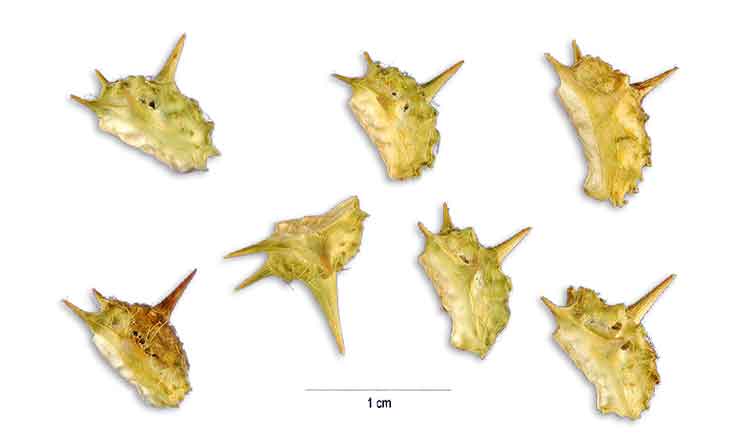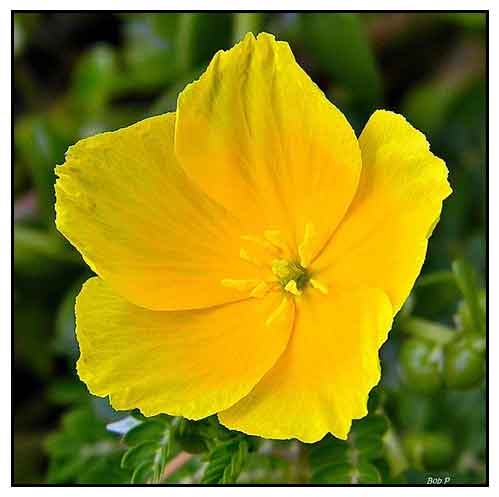
Etymology
Genus name Tribulus comes from tribolos, the Greek word for caltrop, a ghastly four-pointed metal weapon or device used in warfare, thrown on the ground to cripple human troops, cavalry horses. camels, or elephants. The epithet cistoides refers to the similarity of the flowers to the genus Cistus, also called rockrose or labdanum. (9)
Botany
Tribulus is a prostrate or low-spreading, succulent, perennial hairy herb. Stems are long and slender, up to 90 centimeters in length. Leaves are opposite, stipulate, pinnately compound, in 6 to 11 pairs of leaflets. Leaflets are oblong to oblong-lanceolate, 1.5 centimeters long, green above, and gray-pubescent below. Flowers are long-stalked, about 2.5 centimeters, with 5 spreading, roundish, yellow petals. Fruit is a capsule, stellate-shaped, 3- to 5-lobed, with sharp, light-yellow spines.

Distribution
- In waste places along the sandy shores of many coastal towns.
- Cultivated as ground cover.
- Found in most tropical countries.
- In Hawai'i, considered by some as a weed that merits eradication, totally cleared in some beaches and various locations for the pesky spines that puncture rubber slippers.
 Constituents Constituents
- Plant yields flavonoids, flavonol glycosides, steroidal saponins, and alkaloids.
- Methanol extract of aerial parts of T. cistoides yielded nine steroid saponins, including cardioactive cistocardin.
-
Methanolic extract of roots yielded cardioactive saponin-3, along with tribolusin, a pregnance-type glycoside and 8 new cholestane glycosides. D-(+)-pinitol and sucrose were major constituents.
(4)
- Study of petrol extract of aerial parts of Tribulus cistoides yielded three steroid sapogenins and two N-acyltyramines. A methanolic extract yielded nine steroid saponins, among them the cardioactive cistocardin, saponin-3, saponin-4, and saponin-7, along with a furostanol diglycoside, 5'-(hydroxysulphonyloxy) jasmonic acid. D-(+)-pinitol, and sucrose. (11)
Properties
- Considered invasive in many places. Spiny fruits are bothersome "thorn-in-the-side" of bicyclists, garderners and animals. Spiny seeds are caught in humans and animal fur, facilitating its spread. (10)
- Fruits are faintly aromatic, slightly acrid in taste.
- Tribulus species considered anti-inflammatory, diuretic, stimulant, and hepatic.
Parts used
Roots, leaves.
Uses
Edibility
- Leaves reportedly cooked and eaten as vegetable.
Folkloric
- No reported folkloric medicinal use in the Philippines.
- Elsewhere, used for headaches, constipation, nervous conditions.
- Used for water retention and to treat kidney and liver problems.
- Plant used to treat colds, malaria, kidney and bladder problems. Decoction of roots used in children to relieve toothaches. Poultice of pounded leaves and roots used to treat sores, ulcers, and abscesses. (7)
- In Hawaii, leaves and roots of nohu were once used as poultice, pounded and used for a'ai (sores and ulcers) and puho ( abscesses ad burst sores). (9)
Others
- Natural barrier: Although often used as ground, the spiny seed pods may serve better as a natural barrier to prevent creatures from walking across.
Studies
• Cardioactive Saponin: Methanolic extract of roots yielded cardioactive saponin-3, along with tribolusin, a pregnance-type glycoside and 8 new cholestane glycosides. (4)
• Management of Invasiveness: Puncture vine is tolerant to salt and drought conditions. Extensively used as ground cover in some coastal areas, it has become invasive in some places. Seeds are easily spread by machinery, animals, and humans, caught in tires and animal furs facilitating its spread. Seeds are persistent in the environment and may remain dormant in soil for up to 5 years. The first step in preventative management is to limit planting and remove existing plants, preferably before seeds are produced. Mowing is not effective because of prostrate growth habit of the weed. Chemically, glyphosate and dicamba have been used with excellent results. Pre=emergent herbicides can kill seedlings as they germinate, but utility is limited due to soil persistence. (10)
• Cardioactive Steroid Saponins / Aerial Parts: Study of methanolic extract yielded nine steroid saponins, among them the cardioactive cistocardin, saponin-3, saponin-4, and saponin-7. (see constituents above) (11)
Availability
- Wild-crafted.
- Pills, powders, and extracts in the cybermarket.
|

![]()





 Constituents
Constituents
